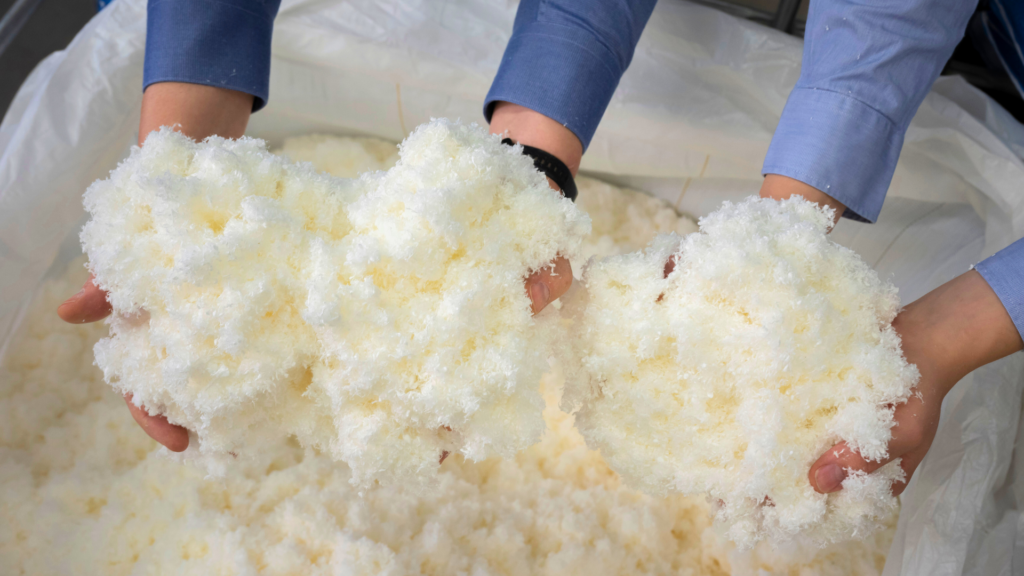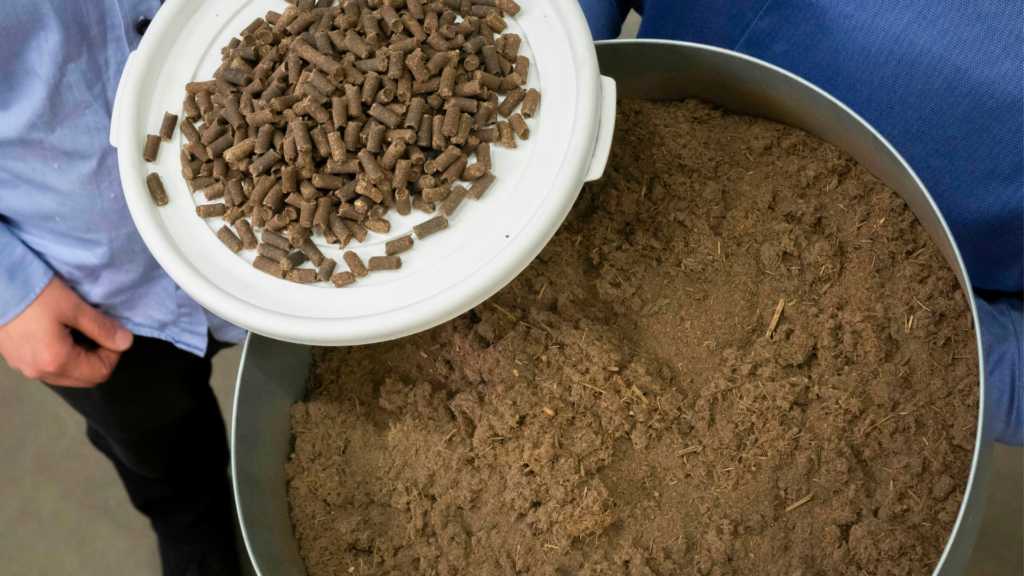Resource-wise, carbon-neutral solutions play a central role in achieving climate goals across various industrial sectors. Cost-effective and energy-efficient drying of biomass has been identified in studies as one of the major obstacles in recycling. Consequently, residual materials have not been optimally utilized.
However, for instance, a recent study highlights the utmost importance of starting to reduce waste and consumption, thereby respecting our resources. A new wave of sustainable, thermal drying technologies has emerged, offering groundbreaking advancements in energy efficiency and environmental impact.
Leading the Way to a Greener Future
From a sustainability standpoint, numerous drying methods remain underdeveloped, particularly concerning environmental and economic considerations. These methods often entail high energy consumption, leading to increased costs, thereby offsetting the benefits that could be derived from the drying process.
Traditional drying methods such as Flash Dryer or Belt Dryer, consume a lot of energy that is often fossil based and tend to emit greenhouse gas emissions, exacerbating climate change. Therefore, the emergence of sustainable drying technologies marks a significant milestone in sustainable practices in many industries.
Unleashing Energy Efficiency Potential
The latest thermal drying technologies are designed to maximize energy efficiency, utilizing innovative heat recovery systems, advanced insulation materials, and optimized process control algorithms. They can also be powered by renewable energy. By significantly reducing energy requirements, these technologies minimize carbon footprints and enable cost-effective operations, making sustainability economically viable for businesses.
Diverse End-Products from Waste

Kuva: Vesa-Matti Väärä / Teknologiateollisuus
Advanced drying technologies bring many benefits: they enable the creation of multiple end-products from bio-based waste- and side streams, in addition to waste reduction and energy efficiency. By applying controlled heating processes, these technologies transform organic waste, such as agricultural residues, food waste, and sewage sludge, into valuable resources.
The dried end products can be used as high-quality biofuels, fertilizers, animal feed, or as raw materials for industrial processes. This holistic approach enables the shift from waste management to circular economy, where materials are reused, recycled, and repurposed, reducing the strain on natural resources and minimizing waste generation.
As different industries embrace these technologies, we can revolutionize waste and water management, reduce greenhouse gas emissions, and create valuable end products from waste. This requires unlearning from old-dated technologies and processes and harnessing smarter, sustainable solutions that contribute to sustainability goals of companies, industries, and governments, allowing them to operate in a greener way.
Different industries generate various side streams and waste streams as byproducts of their operations. These streams often contain valuable materials that can be repurposed, recycled, or transformed into new products, thereby reducing waste and promoting sustainability.
Here are a few examples of outcomes that can be derived from side streams and waste streams in different industries:
Waste-to-Energy
Drying technology enables the easy and energy-efficient transformation of sewage sludge from pulp factory wastewater treatment systems into biofuel pellets. For instance, you can produce fuel pellets from flotation sludge, turning its wastewater sludge into energy and simplifying waste management. This approach also improves the annual water balance and restores mechanical impurities in the sewage.
Transforming waste into new, recycled products

Any fiber containing hemicellulose or polyose can be transformed into high-added value products through gentle drying technology. Drying of agricultural or marine biomass to produce cellulose pulp fibers functions as raw material for several use cases. Recycling side streams promotes a circular economy, enhances resource efficiency, and minimizes deforestation, especially in the forest and paper industries.
Developing a new product by mixing and drying
Drying technologies also enable you to develop new products by combining and drying multiple side streams. For instance, mixing wastewater sludge with ash, yields a product that can be sold as fertilizer or soil conditioner. Dried fiber-rich soil conditioner improves the soil’s water-binding capacity.
Similarly, mixing sludge with sawdust results in a product that can be used as biofuel pellets.
Drying technologies can be effectively applied in several industries. Here are some examples of where drying technologies can be utilized and their potential applications:
Municipal Waste Management
Wastewater Treatment Plants: Drying technologies can be employed to process sludge generated from wastewater treatment plants. The dried sludge can be converted into fuel pellets or bricks, which can serve as a renewable energy source for heating or industrial processes.
Agriculture and Food Processing
Crop Residues and Biomass: Agricultural residue can efficiently be processed and transformed into biochar, biofuels, or other bio-based products, such as animal feed, organic fertilizers, or green building materials.
Fruit and Vegetable Processing: After drying fruit and vegetable waste, they can be transformed into ingredients for food products, such as natural food flavors or nutrient-rich powders used in the production of nutritional supplements.
Manufacturing and Industrial Sectors
Industrial Byproducts: Industrial byproducts can include steel slag or fly ash. The dried materials can then be used as construction materials, aggregates in road construction, or additives in cement production.
Side Streams from Forest Industry: Drying side streams from the forest industry can facilitate their transformation into various products like compressed wood pellets for heating or as a source of raw material for the production of bio-based chemicals and materials.
Residues from Food and Feed Industry: Drying side streams such as fruit peels or leftover grains can create value-added products like animal feed or compost, reducing waste and maximizing resource efficiency.
Packaging Waste: Drying technologies can enable the recycling of packaging waste, such as plastic, paper, or cardboard. By drying and processing these materials, they can be transformed into new packaging materials or plastic pellets for the manufacturing of plastic products.
Energy Production
Biomass Waste: Drying technologies can be applied to biomass waste generated in forestry operations, sawmills, or agriculture. The dried biomass can then be used as a feedstock for biomass combustion, anaerobic digestion, or gasification processes to produce renewable energy, heat, or electricity.
Thermal drying systems play a crucial role in preparing material flows for downstream unit operations, such as, pelletizing. These systems are designed to remove moisture from the feedstock, enhancing its suitability for different applications, such as pelletizing.
Here’s a general overview on the process of how a thermal drying system works before its final application:
Step 1: Feedstock Preparation
The process begins by preparing the feedstock, which can include various materials such as biomass, agricultural residues, or sludge. Depending on the final application, the feedstock can be pre-treated.
Step 2: Loading and Preheating
The prepared feedstock is fed into the thermal drying system. The system typically consists of a drying chamber or conveyor belt, where the material moves through the drying process. Before entering the drying chamber, the feedstock may undergo preheating to elevate its temperature, enhancing the efficiency of the drying process.
Step 3: Drying Process
Inside the drying chamber, the feedstock is subjected to controlled heating. The drying system’s design ensures that the heat is evenly distributed to facilitate efficient and uniform moisture removal from the feedstock.
Step 4: Moisture Evaporation
As the feedstock is exposed to the controlled heat, the moisture within the material starts to evaporate. The heated air or gases in the drying chamber act as a carrier medium, absorbing the moisture released from the feedstock. The moisture-laden air or gases are then directed out of the drying system for further treatment or condensation to recover heat energy.
Step 5: Air or Gas Handling
The moisture-laden air or gases are typically passed through a series of air handling systems, such as cyclones, bag filters, or scrubbers, to remove particulate matter and capture any pollutants or odors.
Step 6: Final Dried Product
After the moisture evaporation process, the feedstock undergoes a transformation, becoming significantly drier and more suitable for pelleting. The specific moisture content required for pelleting depends on the characteristics of the feedstock and the desired quality of the pellets.
It is important to note that the exact design and operation of thermal drying systems can vary depending on the specific technology and application. Factors such as feedstock characteristics, final dry matter content requirements, energy efficiency, and environmental considerations play a significant role in determining the optimal configuration of the thermal drying system.
Gentle drying techniques offer several benefits compared to more aggressive drying methods. These techniques prioritize a careful and controlled approach to moisture removal, providing numerous advantages in various industries and applications. Here are some key benefits of gentle drying techniques:
Preserving Product Quality: Gentle drying techniques aim to minimize thermal and mechanical stresses on the material being dried. By carefully controlling temperature, airflow, and drying time, these techniques help preserve the quality, integrity, and desirable properties of the product.
Retaining Nutritional Characteristics and Energy Content: In the food industry, gentle drying techniques can help retain the nutritional content. By minimizing excessive heat and prolonged drying times, these techniques reduce the degradation of energy and other sensitive components, ensuring that the final product retains its energy content.
Preventing Structural Damage: Aggressive drying methods can cause structural damage to delicate or fragile materials. Gentle drying techniques mitigate this risk by avoiding excessive temperature gradients and reducing the occurrence of cracks, warping, or deformation in the dried material. This is particularly important for materials such as textiles or sensitive chemicals.
Energy Efficiency: While drying processes typically require energy, novel drying techniques can optimize energy consumption. By carefully controlling drying parameters and utilizing advanced heat recovery systems, these techniques maximize energy efficiency, minimizing energy waste and reducing operational costs.
Environmental Considerations: Modern drying techniques often result in lower emissions and reduced environmental impact compared to aggressive drying methods. By operating at lower temperatures and optimizing energy usage, these techniques can help mitigate greenhouse gas emissions and minimize the carbon footprint associated with the drying process. This aligns with sustainability goals and environmental regulations.
Extended Equipment Lifespan: Aggressive drying methods can place significant stress on drying equipment due to high temperatures and rapid airflow rates. Gentle drying techniques, by contrast, subject the equipment to less strain, potentially extending its lifespan and reducing maintenance requirements. This leads to cost savings and improves overall operational efficiency.
Process Flexibility: Gentle drying techniques can be tailored to suit different materials, sizes, and moisture content requirements. The flexibility of these techniques allows for customization and optimization of the drying process for specific products or applications. This adaptability is valuable in industries with multiple side and waste streams.
Unlocking New Possibilities with Scalable Technologies
When it comes to advanced technologies, their energy efficiency and design for industrial-scale operations not only reduce costs but also facilitate economically sustainable processes. This can lead to improved business feasibility and profitability.
One of the primary limitations of many drying technologies is their limited scalability and high energy consumption. In addition, drying has not been profitable, primarily due to factors such as high energy demand.

Kuva: Vesa-Matti Väärä / Teknologiateollisuus
To unlock the potential that lies in your biomasses or residuals, SuperDryer™ by TM Systems is a scalable solution that can handle large volumes of material efficiently, and even carbon negatively. The technology can be fitted to your existing processes with minimal effort.
The ability to scale up the system opens doors to a wide range of industries, including forestry, food and feed industry, textile industry, agriculture, municipal waste management, and biomass utilization. This scalability empowers businesses and communities to tackle waste challenges effectively, reducing landfill dependence and promoting sustainable practices.
In summary, drying technologies can find applications in various industries to process different types of waste- and side streams. By efficiently drying and processing these materials, industries can reduce waste, recover valuable resources, and create sustainable products, contributing to a more circular and environmentally friendly economy.
Gentle drying technologies such as SuperDryer™ offer numerous advantages, including preserving product quality, retaining nutritional and flavor characteristics, preventing structural damage, improving energy efficiency, reducing negative environmental impact, extending equipment lifespan, and providing process flexibility. These benefits make the technology highly desirable for industries that prioritize high-quality products, sustainability, and energy efficiency.
